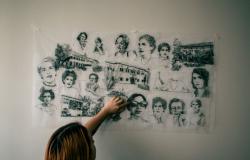To get to know Salvador Dalí there is no better option than to travel to the place where he was born, lived, created, loved and died, and that place is none other than the region of l’Empordà, in the province of Girona. Only by knowing his surroundings can we understand how the surrealist mind of the Catalan artist gained such international relevance without disconnecting from the roots that united him to his land.
The Dalinian Triangle is formed by joining Figueres, Portlligat and Púbol, on the Costa Brava, and traveling through these three municipalities we will visit the Theater-Museum that he himself wanted to create for his work, the house by the sea in which he lived for 40 years and the medieval castle that he gave to Gala, his partner and muse. The three spaces are managed by the Salvador Dalí Foundation and through their website you can buy tickets for any of them in advance.
If you want to go beyond Dalí’s work and delve into his life, his environment and his most intimate art, then this route is made for you.
Dalí Theater-Museum in Figueres
We begin where Salvador Dalí’s life began and ended, in Figueres. The artist was born here in 1904 and here he died in 1989. Our direction must be towards the Dalí Theatre-Museum, considered in itself the largest surrealist object in the world. The building was designed by the artist himself to be built on the remains of the old theater of Figueres, destroyed during the Spanish Civil War, and inside, as a museum, we find a large number of the artist’s masterpieces. We will see a little of everything: painting, drawing, sculpture, engraving, installation, hologram, stereoscopy and photography to review the multiple Dalinian facets.
Dalí wanted to build this museum to house his work, its transparent geodesic dome has become a symbol for the city and both the interior and exterior are full of surrealist, impressionist, futurist and cubist nods. Although it was not the painter’s will, since his idea was to end up with his wife Gala in Púbol, his remains rest buried here.
“Where, if not in my city, will the most extravagant and solid part of my work endure, where else? The Municipal Theater, what was left of it, seemed very appropriate to me, and for three reasons: first, because I am an eminently theatrical painter; the second, because the theater is right in front of the church where I was baptized; and the third, because it was precisely in the lobby room of the Theater where I exhibited my first painting sample.”
In Figueres, there is also the birthplace of Salvador Dalí. A modernist building from 1898 located on Monturiol Street in which the family lived on the mezzanine until 1912, at which time they moved to another house on the same street. Dalí’s birthplace is a museum to receive visitors and offer through images, spaces, objects, holograms, mappingsvisual effects, giant kaleidoscopes and immersive landscapes, a journey with which to review his work from his childhood to the mass baths.
Salvador Dalí House-Museum in Portlligat
This was Dalí’s only stable residence. In 1930 the artist settled in an old fishing hut in Portlligat, in Cadaqués, attracted by the landscape, the light and the isolation of the place, and he lived and worked there until his wife Gala died in 1982 and he decided to move to Púbol. . For forty years the couple expanded the initial construction and acquired others nearby to gradually create the labyrinthine complex that we can visit today. When the Civil War broke out, Dalí and Gala moved to the United States and did not return to Portlligat until the end of 1948, but except during that period the house did not stop growing with different rooms.
Today, when we visit the Salvador Dalí House-Museum in Portlligat we see how the Bear Hall acts as the epicenter and from it small rooms emerge connected by corridors and slopes. We will pass through Dalí’s workshop, the library, the private rooms, the garden and the pool, and never lose sight of, through its irregular windows, the bay of Portlligat, so present in Dalí’s work. To make the visit as realistic as possible, the museum tries to keep the furniture as it was when the Empordà artist lived there.
“Portlligat is the place of achievements. It is the perfect place for my work. Everything conspires to make it so: time passes more slowly and each hour has its right dimension. There is a geological tranquility: it is a unique planetary case.”
Gala Dalí Castle in Púbol
Dalí promised Gala to make her queen of a castle and this was the result. We are in Púbol, a small town belonging to the municipality of La Pera, and here in 1969 the painter acquired this medieval castle to give it to his wife and with it fulfill his promise. Its restoration and decoration required a great creative effort, but the result was undoubtedly worth it. With this castle, the artist’s only objective was focused on creating an appropriate place to offer rest and refuge to Gala. So much so that it ended up becoming the mausoleum of her muse.
The Gothic-Renaissance building has been documented since the 11th century and when it was acquired it was in a practically ruined state and a garden in a semi-wild state. Dalí created unexpected spaces with semi-ruined walls and roofs using pictorial representations and false architecture, textile baroque style, antiques and romantic symbology. All in order to achieve an intimate, almost mysterious, but always harmonious and beautiful space. A good example of this is the old kitchen converted into a bathroom or the Piano Room.
Púbol became an extension of Portlligat with its own personality. It has been open to the public since 1996 and touring its different rooms we can see elements such as Gala’s collection of haute couture dresses or the Cadillac that belonged to the couple. Gala was buried in the crypt in 1982, that same year Salvador Dalí was named Marquis of Púbol by King Juan Carlos I and, after leaving Portlligat with Gala’s death, the castle was the artist’s last workshop until 1984.
Just as Dalí wished, Púbol became Gala’s refuge “where she reigns as absolute sovereign, to the point that I do not visit her except with a written invitation from her hand. I have been content to decorate her ceiling so that, when I lift my eyes from her, I always find myself in her sky.”






